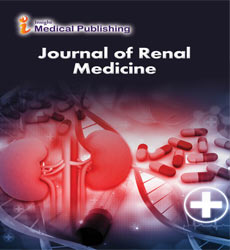Advancement of Diabetic Nephropathy
Simon Gilmore*
Department of Clinical Epidemiology, Aarhus University, Aarhus, Denmark
- *Corresponding Author:
- Simon Gilmore
Department of Clinical Epidemiology,
Aarhus University, Aarhus,
Denmark,
E-mail: S.gilmore78@gmail.com
Received date: December 19, 2023, Manuscript No. IPJRM-24-18580; Editor assigned date: December 22, 2023, PreQC No. IPJRM-24-18580 (PQ); Reviewed date: January 05, 2024, QC No. IPJRM-24-18580; Revised date: January 12, 2024, Manuscript No. IPJRM-24-18580 (R); Published date: January 19, 2024, DOI: 10.36648/ipjrm.7.1.6
Citation: Gilmore S (2024) Advancement of Diabetic Nephropathy. Jour Ren Med Vol. 7 No.1:06.
Description
Diabetic nephropathy is the main source of constant kidney illness in patients beginning renal supplanting treatment and is related with expanded cardiovascular mortality. This stage has been alluded to as obvious nephropathy, clinical nephropathy, proteinuria, or macroalbuminuria. This phase of renal inclusion was named microalbuminuria or nascent nephropathy. Among patients beginning renal substitution treatment. In any case, the execution of these actions is far underneath the helpful objectives. The point of this article is to talk about the techniques for early screening and finding of diabetic nephropathy and the remedial procedures that advance reno and cardioprotection in this high-risk gathering of patients, to decrease the occurrence of diabetic nephropathy and its related cardiovascular mortality.
Screening for Diabetic Nephropathy
Evaluating for diabetic nephropathy should be started at the hour of determination in patients with type 2 diabetes, For patients with type 1 diabetes, the main screening has been suggested at 5 years after analysis. Besides, adolescence is an autonomous gamble factor for microalbuminuria. In this way, in type 1 diabetes, evaluating for microalbuminuria may be performed 1 year after diabetes determination, particularly in patients with poor metabolic control and after the beginning of pubescence. In the event that microalbuminuria is missing, the screening should be rehashed every year for both sort 1 and 2 diabetic patients.
Differential Diagnosis
The most vital phase in the screening and conclusion of diabetic nephropathy is to quantify egg whites in a spot pee test, gathered either as the primary pee in the first part of the day or at irregular, for instance, at the clinical visit. The aftereffects of egg whites estimations in spot assortments might be communicated as urinary egg whites focus or as urinary egg whites to creatinine proportion. Despite the fact that communicating the outcomes as egg whites fixation may be affected by weakening or centralization of the pee test, this choice is as yet precise and less expensive than articulation as egg whites to-creatinine proportion. Screening ought not be acted in that frame of mind of conditions that increment, like urinary parcel contamination, hematuria, intense febrile sickness, overwhelming activity, momentary articulated hyperglycemia, uncontrolled hypertension, and cardiovascular breakdown. In any case, it was as of late exhibited that regular immunochemical-based examines didn't distinguish a lifeless part of albuminuria. Elite execution fluid chromatography estimates all out egg whites, including immunoreactive and immunounreactive structures, and may permit early location of nascent diabetic nephropathy. In circumstances where explicit estimations are not accessible, semiquantitative dipstick estimations of albuminuria, can be utilized. Another option is to involve a subjective test for proteinuria or a quantitative estimation of protein in a spot pee test. In patients with type 1 diabetes, this peculiarity is by all accounts more normal among female patients with longstanding diabetes, hypertension, or potentially retinopathy. Albeit renal biopsy was not played out, this perception was presumably connected with renal parenchymal infection other than traditional diabetic glomerulosclerosis.
Diabetic nephropathy doesn't foster in that frame of mind of hyperglycemia, even within the sight of a hereditary inclination. Multigenetic inclination contributes in the advancement of diabetic nephropathy, accordingly supporting that many elements are associated with the pathogenesis of the illness. Hyperglycemia prompts renal harm straightforwardly or through hemodynamic changes. It prompts initiation of protein kinase C, expanded creation of cutting edge glycosylation finished results, and diacylglycerol amalgamation. Moreover, it is answerable for hemodynamic changes, glomerular hyperfiltration, shear pressure, and microalbuminuria. Subsequently actuating mesangial development and glomerular cellar film thickening. Nonetheless, low enzymatic debasement of extracellular framework adds to an over the top collection. Since hyperglycemia is the chief variable answerable for primary adjustments at the renal level, glycemic control stays the fundamental objective of the treatment, though pancreas transplantation is the best methodology for diminishing the renal injuries.
Diabetic nephropathy is a clinical disorder portrayed by the event of relentless microalbuminuria in concomitance with insulin or non-insulin-subordinate diabetes. Afterward, during a course, the patient shows a slow decay of the GFR and steadiness of microalbuminuria that precedes gentle and in this manner moderate proteinuria. The last step of the normal history of the illness is portrayed by extreme proteinuria despite everything nephrotic condition and ongoing renal inadequacy that downfalls. The continuous debilitation of the above lab discoveries is brought about by primary changes at the renal level, which toward the starting comprise of a slow and moderate gathering of Extracellular Network (ECM) in the mesangium and glomerular storm cellar film.
Open Access Journals
- Aquaculture & Veterinary Science
- Chemistry & Chemical Sciences
- Clinical Sciences
- Engineering
- General Science
- Genetics & Molecular Biology
- Health Care & Nursing
- Immunology & Microbiology
- Materials Science
- Mathematics & Physics
- Medical Sciences
- Neurology & Psychiatry
- Oncology & Cancer Science
- Pharmaceutical Sciences
